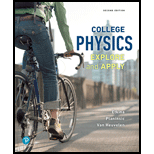
Review Question 9.1 Visualize an ice skater rotating faster and faster in a clockwise direction What are the signs of rotational velocity and rotational acceleration? As the skater starts slowing down, what are the signs of rotational velocity and acceleration?
To explain: The signs of rotational velocity and rotational acceleration when an ice skater starts rotating faster and faster in the clockwise direction. Also, explain the signs of rotational velocity and rotational acceleration when the skater starts slowing down.
Answer to Problem 1RQ
Solution:
When the ice skater is rotating faster and faster, the signs of rotational velocity and rotational acceleration are negative. However, when the ice skater is slowing down, the sign of rotational velocity remains negative whereas that of rotational acceleration becomes positive.
Explanation of Solution
Introduction:
Rotational velocity is the rate of change of the angular position of a body rotating about a center or any point within a given period of time. It is written as:
Here,
The rate of change of angular velocity is called rotational acceleration. It is written as:
Here,
When an object is rotating in the clockwise direction, the sign of rotational velocity is taken as negative, and vice versa. The sign of rotational acceleration is the same as that of rotational velocity when rotational velocity is increased, but opposite when rotational velocity is decreased.
Explanation:
When an ice skater is rotating faster and faster in the clockwise direction, it is clear that the rotational velocity is increasing with respect to time. The sign of rotational velocity depends on the direction of rotation of the object. If the object is rotating in a clockwise direction, the sign will be negative, and vice versa.
In the given problem, the ice skater is rotating in the clockwise direction; so, rotational velocity is negative. The sign of rotational acceleration is also negative because rotational velocity is increasing with respect to time and thus rotational acceleration will have same sign as that of rotational velocity.
The second case, when the ice skater is slowing down, but rotating in a clockwise direction, signifies that the sign of rotational velocity is negative but that of rotational acceleration is opposite to the sign of rotational velocity as velocity is decreasing with respect to time. So, the sign of angular acceleration, in this case, will be positive.
Conclusion:
Hence, it is clear that when the ice skater is rotating faster and faster, rotational velocity and rotational acceleration are negative as per the sign convention. On the other hand, when the ice skater is slowing down, the rotational velocity has a negative sign while rotational acceleration has a positive sign.
Want to see more full solutions like this?
Chapter 9 Solutions
College Physics
Additional Science Textbook Solutions
Anatomy & Physiology (6th Edition)
Chemistry & Chemical Reactivity
Human Anatomy & Physiology (2nd Edition)
Cosmic Perspective Fundamentals
Microbiology: An Introduction
Human Physiology: An Integrated Approach (8th Edition)
- A capacitor with a capacitance of C = 5.95×10−5 F is charged by connecting it to a 12.5 −V battery. The capacitor is then disconnected from the battery and connected across an inductor with an inductance of L = 1.55 H . At the time 2.35×10−2 s after the connection to the inductor is made, what is the current in the inductor? At that time, how much electrical energy is stored in the inductor?arrow_forwardCan someone help me with this question. Thanks.arrow_forwardCan someone help me with this question. Thanks.arrow_forward
 Physics for Scientists and Engineers, Technology ...PhysicsISBN:9781305116399Author:Raymond A. Serway, John W. JewettPublisher:Cengage Learning
Physics for Scientists and Engineers, Technology ...PhysicsISBN:9781305116399Author:Raymond A. Serway, John W. JewettPublisher:Cengage Learning Principles of Physics: A Calculus-Based TextPhysicsISBN:9781133104261Author:Raymond A. Serway, John W. JewettPublisher:Cengage Learning
Principles of Physics: A Calculus-Based TextPhysicsISBN:9781133104261Author:Raymond A. Serway, John W. JewettPublisher:Cengage Learning College PhysicsPhysicsISBN:9781938168000Author:Paul Peter Urone, Roger HinrichsPublisher:OpenStax College
College PhysicsPhysicsISBN:9781938168000Author:Paul Peter Urone, Roger HinrichsPublisher:OpenStax College University Physics Volume 1PhysicsISBN:9781938168277Author:William Moebs, Samuel J. Ling, Jeff SannyPublisher:OpenStax - Rice University
University Physics Volume 1PhysicsISBN:9781938168277Author:William Moebs, Samuel J. Ling, Jeff SannyPublisher:OpenStax - Rice University College PhysicsPhysicsISBN:9781285737027Author:Raymond A. Serway, Chris VuillePublisher:Cengage Learning
College PhysicsPhysicsISBN:9781285737027Author:Raymond A. Serway, Chris VuillePublisher:Cengage Learning Physics for Scientists and Engineers with Modern ...PhysicsISBN:9781337553292Author:Raymond A. Serway, John W. JewettPublisher:Cengage Learning
Physics for Scientists and Engineers with Modern ...PhysicsISBN:9781337553292Author:Raymond A. Serway, John W. JewettPublisher:Cengage Learning





